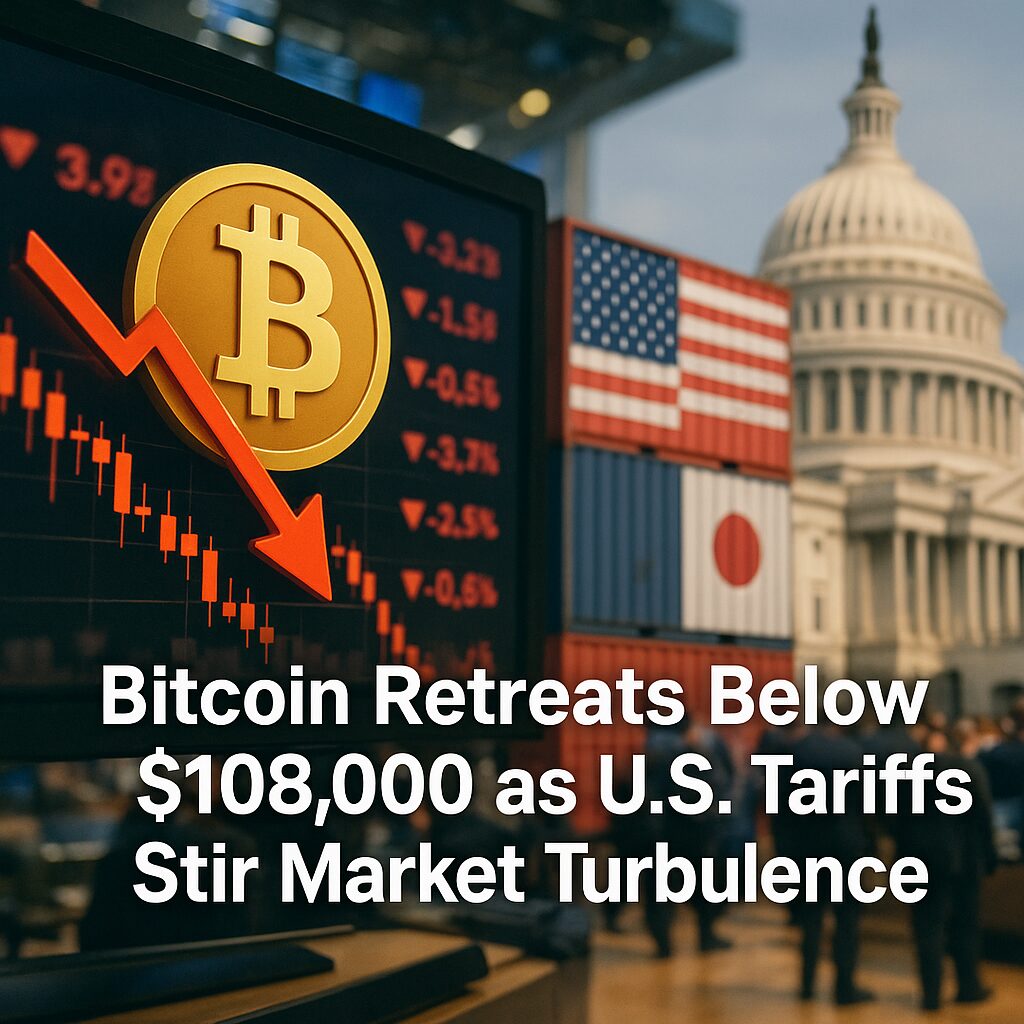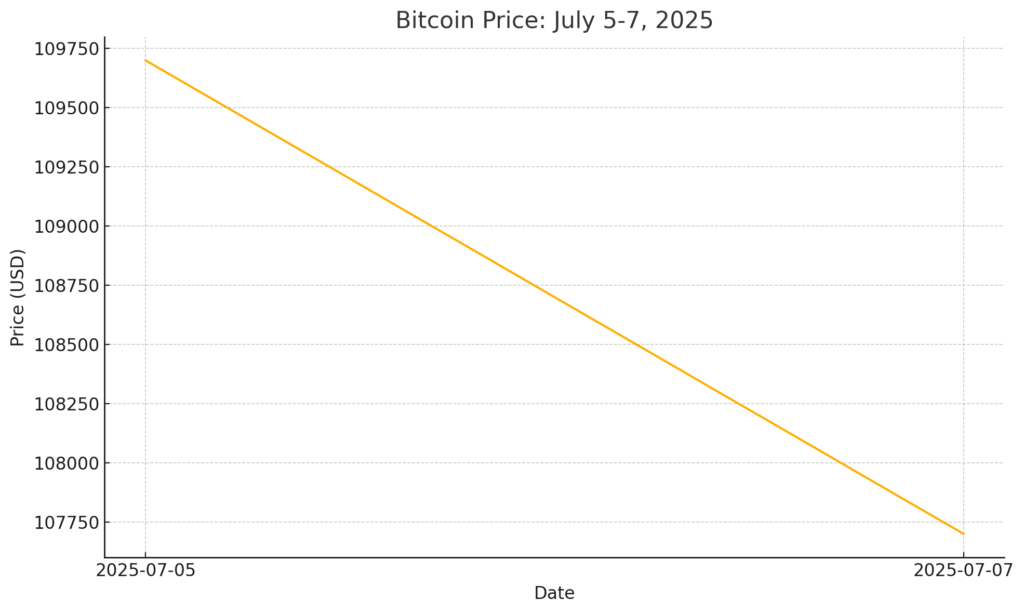
Main Points:
- Bitcoin slipped below $108,000, erasing modest weekend gains.
- Ethereum, Solana, Dogecoin, and SUI each fell 0.6–2%, while XRP rose over 2%.
- President Trump announced 25% tariffs on Japanese and South Korean imports effective August 1, extending a trade-agreement deadline from July 9 to August 1.
- Additional tariffs on BRICS-aligned countries were threatened, fueling investor uncertainty.
- U.S. equities dipped roughly 1%, and 10-year Treasury yields approached 4.4%.
- Implications for crypto include short-term volatility, potential dollar-crypto correlations, and strategic blockchain opportunities.
Market Reaction to Weekend Gains
Over the U.S. trading session on July 7, Bitcoin reversed its subdued weekend rally, falling below $108,000 and declining 0.8% over the past 24 hours—a move that wiped out gains made during the previous two days. After touching a local high of approximately $109,700 on Sunday, the world’s largest cryptocurrency slumped to around $107,700 by early afternoon.
Altcoins broadly mirrored Bitcoin’s downturn. Ethereum (ETH) dropped 0.6%, Solana (SOL), Dogecoin (DOGE), and SUI each slid 1–2%, while XRP bucked the trend, surging over 2% as traders rotated into perceived value plays. The sudden shift in crypto sentiment underscores the market’s sensitivity to macroeconomic policy announcements.
Tit-for-Tat Tariffs Escalate Trade Tensions
In a surprise move on July 7, President Donald Trump announced 25% tariffs on goods imported from Japan and South Korea, effective August 1, via letters shared on his social media platform. This action extends the U.S. trade-agreement deadline from the previously set July 9 to August 1, signaling a firmer negotiating stance.
Trump’s letters also hinted at additional tariffs targeting countries aligning with BRICS policies—a coalition that includes Brazil, Russia, India, China, and South Africa. White House spokesman Andrew Leavitt indicated that further notifications of tariff rate changes could be sent to other nations in coming days. The prospect of escalating trade barriers has unnerved global markets, contributing to risk-off flows into safe-haven assets such as U.S. Treasuries.
Broader Financial Markets Feel the Pinch
Equity markets reflected the heightening trade friction: the S&P 500 dropped about 1%, while the Nasdaq and Dow Jones each fell nearly 0.9% on July 7. Companies with significant exposure to Asian exports were among the hardest hit, as investors reassessed corporate earnings outlooks under higher tariff regimes.
Simultaneously, 10-year U.S. Treasury yields climbed toward 4.4%, the highest levels seen in several weeks. Rising yields suggest growing inflationary expectations, which can put additional downward pressure on interest-rate–sensitive assets, including cryptocurrencies.
Crypto-Specific Drivers and Dollar Dynamics
Analysts note that market participants often treat cryptocurrencies as a hedge against a weakening dollar, yet at times they also move in tandem with broad risk appetite. The recent tariff-driven spike in uncertainty briefly strengthened the U.S. dollar index, compressing Bitcoin’s price as traders sought liquidity and safety.
However, some experts argue that sustained dollar softness—stemming from trade deficits exacerbated by tariffs—could eventually buoy cryptocurrencies over the medium term. If the dollar weakens significantly, Bitcoin and other digital assets may regain momentum as alternative stores of value.
Practical Implications for Crypto Investors
- Short-Term Volatility: Be prepared for heightened swings in crypto prices tied to geopolitical developments. Consider setting stop-loss orders or scaling position sizes to manage risk.
- Diversification: While Bitcoin leads market moves, altcoins like XRP and emerging tokens may present trading or yield opportunities, especially when they diverge from Bitcoin’s trajectory.
- Blockchain Use Cases: Rising trade tensions could accelerate interest in permissioned blockchain networks for supply-chain finance, cross-border settlements, and real-time customs tracking. Firms exploring these applications may see increased demand for enterprise blockchain solutions.
Graphical Overview
Below is a simple price chart illustrating Bitcoin’s modest rally to $109,700 on July 5 and its retreat to roughly $107,700 by July 7.

(See graph above generated via python.)
Conclusion
The confluence of renewed U.S. trade tensions, sparked by 25% tariffs on Japan and South Korea, and broader macroeconomic shifts has injected fresh volatility into cryptocurrency markets. Bitcoin’s slide below $108,000 eroded weekend gains, while altcoins experienced mixed reactions. Equity markets and bond yields also felt the impact, reflecting the interconnectedness of global financial systems. For crypto investors, these developments highlight both short-term risks and longer-term opportunities—particularly in diversifying portfolios, leveraging blockchain’s practical applications, and monitoring dollar dynamics. As policymakers push for stronger trade postures, market participants should stay vigilant, ready to adjust strategies in response to evolving headwinds.

